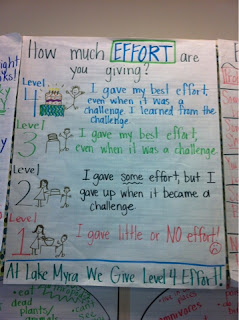Peer- and Self-assessment (PASA) can provide huge
benefits in helping students achieve! Peer-assessment
is when students to provide each other with valuable feedback so they can learn
from and support each other (Swain, 2010). It provides the opportunity to
discuss, listen, explain, and challenge each other. Self-assessment is when students form judgments about their own
work. It promotes independent learning and helps students take responsibility
for their learning progress.Here is a great video of self-assessment implemented in a Grade 2 classroom:
ExemplarsK12. (2011, Nov 11). Exemplars, Grade 2 - Self-Assessing [video file]. Retrieved from: https://www.youtube.com/watch?v=P0BrgA7zX10
These types of assessments cannot be used for grades and
Ontario actually prohibits it! The assessment
information is used by students to improve their learning (Drake, Reid, &
Kolohon, 2014). For PASA to be effective, students need to be explicitly taught
about assessment. Like teachers, students need to become assessment literate! Students must have a clear understanding of the
expectations and criteria of assessments. This can be done by breaking down
rubrics into language that is easy to understand or even creating rubrics together
with students! I remember receiving rubrics in elementary school for many assignments and projects. However, I often did not understand what the terms meant or how to use it, making it meaningless for me!
 |
| Retrieved from http://www.allstudentscanshine.com/2012/06/ice-cream-craftivity-and-smiley.html |
In addition, students need to know the characteristics of
different levels of quality work and know what it looks like. One way to
demonstrate this to students is by applying rubrics to examples of different
levels of work. In my Grade 1 classroom at my placement, there was a visual
with ice-cream sundaes that had various amounts of scoops of ice cream and
toppings (similar to the "Smiley Sentences" picture) to demonstrate
the characteristics of level 1 to 4 work, such as using grammar, capital
letters to begin sentences, finger spaces, and punctuation. It was great to see the student refer back to it when working on their writing tasks.
 |
| Retrieved from:
|
Teachers must also teach students how to give appropriate
feedback to their peers, such as teaching them sentence starters like “I was
confused when…” and “I liked it when you…”. For PASA to be successful, students need to view
mistakes as an opportunity for learning (aka have a growth mindset) and be
encouraged to engage in honest reflection. Teach Primary provides some great sentence starters!
 |
| Retrieved from http://educationtothecore.com/2013/04/anchor-charts/ |
- Evaluation skills: developing the capacity to assessing one’s own work and achievement
- Reflection skills: reflecting on achievements and connecting work to learning outcomes and criteria
- Meta-cognition skills: Monitoring their learning, thinking about how I learn best, see where they are in their learning process, and what strategies should be used to improve learning
- Goal setting skills: deciding what they need to do to become successful
- Develop independence, accountability, and self-regulation by become effective assessors of their own learning
- Improvement: Gaining a better understanding of criteria and is useful for teachers to improve instruction by having students communicating their understandings to teachers
- Social interaction between peers and encourages communication with teachers and parents about their learning
PASA prepare students for the future because they learn
skills that can be applied to a variety of contexts. Swain (2010) mentioned
that PASA prepares students for learning environments like college and
university because it teaches students to value their own evaluations or
opinions of their work and learn how to improve.
There are several benefits of PASA and it promotes many
21st century skills. However there are some challenges involved that
Harris & Brown (2013) mentioned:
- Concerns about cheating and inaccuracy
- Parents and the community may not see the value of peer and self-evaluations since it is the responsibility of the teacher to assess students
- May not be possible in all classrooms because positive classroom relations between the teacher, students, and their peers are required
I think a big issue for peer-assessment would be the social
relations between students. Some students may not feel comfortable to respond
honestly because they may want to please others and maintain friendships, which
may lead to accuracy issues. When I was in Grade 4, we would often edit our classmates' writing. When I edited my friend's work, I would be afraid of hurting her feelings if I pointed out her mistakes! In addition, some assessments may be difficult to
assess due to creative aspects of assignments. What other challenges do you think may occur with implementing PASA?
Drake et al. (2014) provided some self-assessment activities,
such as journal or learning log, blogs, student-teacher or peer conferences or
interviews, rubrics, and checklists. Below are additional ways to implement
self-assessment and peer-assessment. Also, Teach Primary provides explanations
for some of the strategies as well as other great strategies.
How would you implement PASA? Do you remember any
experiences of self-evaluation or peer evaluation that has contributed to your
learning? How early can PASA be implemented (i.e. do you think it could be
implemented beginning in Kindergarten)?
 |
| Retrieved from http://www.helloliteracy.com/2012/06/halls-and-walls-of-lake-myra-first.html |
 |
| Two Stars and a Wish. Retrieved from http://www.communication4all.co.uk/http/Thinking.htm |
 |
| The Sandwich Method. Retrieved from http://coonleyschoolartstudio.blogspot.ca/2012/03/reflecting-on-our-work.html |
 |
| Post-It Note Critque. Retrieved from: http://ibartstudio.blogspot.ca/2011/09/post-it-note-critique.html |
References
Harris, L. R., & Brown, G. T. (2013). Opportunities
and obstacles to consider when using peer- and self-assessment to improve
student learning: Case studies into teachers' implementation. Teaching And
Teacher Education, 36101-111. doi:10.1016/j.tate.2013.07.008
Swain, B. (2010, September 17). The importance of peer
and self assessment . Scholastic.
Retrieved from: http://education.scholastic.co.uk/content/13153

